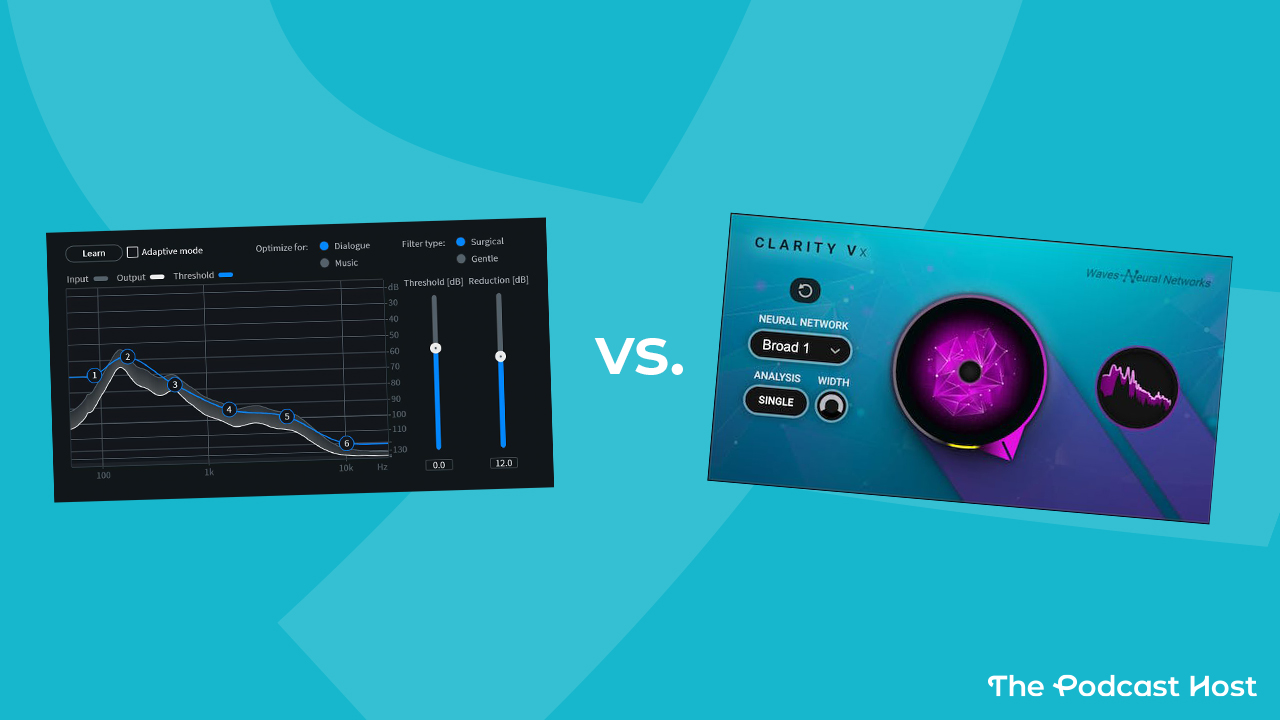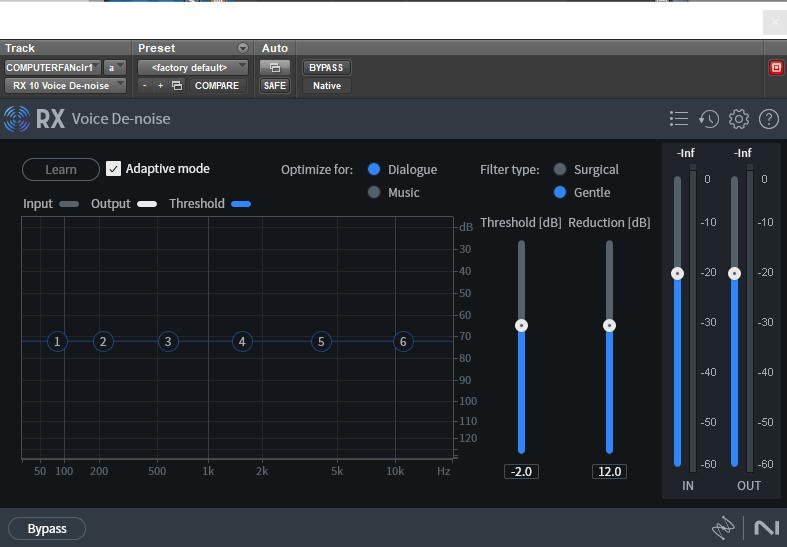Clarity Vx vs Rx Voice De-Noise: Best Noise Reduction Plugin?

There are many different types of noise-reduction software. Their price ranges also can be anywhere from free up to considering selling a kidney (don’t sell your kidney).
Choosing the right noise-reduction tool can feel daunting if you don’t have a background in audio. Truth be told, each one does their job a little differently. This is not necessarily good or bad, but it can add to the confusion. In this article, I’ll dissect the differences between two popular noise-reduction tools, RX Voice-Denoise from iZotope and Clarity Vx from Waves. I’ll also run some tests to see how they perform with podcasting in mind.
What is Noise Reduction?
Noise reduction can be traced to its infancy all the way back to the 1940s. Initially, it resembled more of a filter where high frequencies were targeted. Today, this would resemble a low-pass filter.
Fast-forward to modern times, and noise reduction is primarily in software format. It became far more advanced once spectral technologies were introduced for more complex removal. The primary purpose of noise-reduction software is to lessen or remove room tone-like sounds that distract from the voice, for example – fans, HVAC systems, hiss, etc…
This technology is ever-evolving. For instance, some can remove or lessen transient sounds like doors or footsteps, but it’s still very much hit-or-miss, so manual repair is often needed if re-records are not an option. That’s why it’s always important to treat your recording space as best as you can!
But, despite our best efforts, sometimes noise seeps into recordings. Here are a couple of tools to help temper it.
RX Voice De-Noise by iZotope
RX Voice De-Noise from iZotope is one of the popular plugins you’ll come across in podcasting. That said, you can’t buy it as a stand-alone tool – you need RX Standard or Advanced to use it.
RX Voice De-Noise implements the traditional style of early de-noise software:

As you can see, it uses a Threshold and Reduction slider with a “learn noise profile” system, which can be a bit confusing at first. Luckily for beginners, it has an automatic setting where the threshold will, as the name suggests, automatically adapt throughout the recording. The trade-off is that it usually processes at lower amounts to avoid audio artifacts – unwanted sounds introduced from plugin processing.
Clarity Vx by Waves
Clarity Vx has a pro version that utilizes a similar method to RX Voice De-Noise for settings, but the standard version with one knob will more than suffice for a podcaster. Yes, that’s right, one knob! For settings, all you do is use one knob that is equivalent to telling the plugin how much processing to apply. Clarity takes care of the other tech stuff under the hood, so to speak.

Noisy Neighbour Test
I’ve used the same test recording for both Clarity and RX. Take a listen to the raw recording of a simulated noisy neighbor slamming doors.
Noisy Neighbour Test: Clarity Vx
First up is Clarity Vx. I used the Broad 2 setting at 67.8.
Unfortunately, there are still some door slams, but even worse, major artifacts are introduced. Where the voice and door overlap, there’s some tonal weirdness that doesn’t exist in the raw recording.
Noisy Neighbour Test: RX Voice De-Noise
I used Voice De-Noise’s podcast preset, which operates with their automatic settings. As you can hear, it doesn’t touch the doors at all.
I fully expected Clarity Vx and Voice De-Noise to operate as they did. Noise reduction technologies aren’t designed to target transient material like doors… at least not yet.
Sometimes, you can luck out with Clarity Vx, but most of the time, manual repair is needed for such noises. For the average podcaster, if you hear doors, footsteps, dog barks, etc, you’re better off holding off on recording, as inconvenient as that is, if your space doesn’t keep external sounds out.
Fan Test
Here is the raw file I’m using for the fan test where a loud fan/vent is within my recording space:
Fan Test: Clarity Vx
Now the processed file using Clarity Vx:
As you can hear, the fan noise has been tamed. I am using the Broad 2 setting at 60.1. There is no noticeable degradation to my voice.
Fan Test: RX Voice De-Noise
Again, I am using the podcast preset for this test.
Rx gets the job done, but I think Clarity Vx does a better job. There’s still a bit of fan noise left, but there’s also some slight artifacting going on.
Pros and Cons Of Clarity Vx
Pros
- Regularly goes on sale
- Less likely to create audio artifacts
- User-friendly UI
Check the current price of Clarity Vx. This is an affiliate link which helps support our free content, at no extra cost to you!
Cons
- CPU heavy
- Not a lot of manual control for the standard version if needed/wanted
Pros and Cons of RX Voice De-Noise
Pros
- Less CPU intensive compared to Clarity Vx
- Manual control and automatic options available
- Clean UI
Cons
- Cannot purchase JUST RX Voice De-Noise as it’s only available in a bundle
- Easier to overuse, resulting in artifacts with noise still left over
- Doesn’t clean as detailed as Clarity Vx (in my opinion)
Conclusion: Best Noise Reduction Plugin?
There is no perfect audio repair tool. Depending on the scenario, I rotate between four to five different noise reduction tools (both Clarity Vx and RX tools included). Some tools work better than others in a given situation but fall short in another.
For podcasters, either Clarity Vx or RX Voice De-Noise will assist you in noise cleanup. Voice De-Noise sometimes needs a bit more manual tweaking to its settings to hone in on the issue. Clarity Vx is very much a set-and-forget. However, at the end of the day, it’s always best to record as cleanly and properly as possible rather than “fix it in post”.
Clarity Vx: My Rating – 4.7
- UI Friendliness 5/5
- Ease of Use 5/5
- Performance 4.5/5
- Computer Resources to Run Smoothly 4/5
RX Voice De-Noise: My Rating – 4.5
- UI Friendliness 4/5
- Ease of Use 4/5
- Performance 4/5
- Computer Resources to Run Smoothly 4/5
Noise Reduction Alternatives
There are no shortage of noise reduction alternatives out there on the market. You can use Audacity for free, which does a pretty good job, especially at that price point. There’s also Alitu, a complete all-in-one podcast maker software for podcasters. It runs things like noise reduction, compression, and EQ for you automatically, and you can record, edit, and publish your podcast from within its easy-to-use interface!

